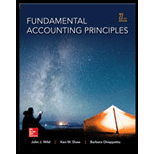
Concept explainers
Concept Introduction:
Inventory: These are goods which are owned by company and expected to sell in its normal course of business
Merchandise: The goods are referred as merchandise which the company purchases and resells the same goods to customers
Merchandiser: The Company who business is to buy the merchandise at purchases cost and sell the same merchandise at higher price which is sales price and earns profit. Merchandiser can be categorized as wholesaler and retailer
Perpetual Inventory System: Each merchandise purchase and sales cost are recorded and updated continuously for all merchandise. In perpetual Inventory system if merchandise is sold. The company determines the cost of goods sold and passes an accounting entry. It will debit “Cost of goods sold” and credit “Merchandise Inventory” . If merchandise is purchased it will pass the accounting entry by debiting “Merchandise Inventory” and crediting “Account payable” if purchases on credit or “Cash or Bank “if paid Cash or Cheque for the purchases
Sales under perpetual Inventory System: when merchandiser sells the goods it can be through cash sale or credit Sale. There will be two entries for each sales transaction as explained below
- When sale of merchandise is made as per revenue recognition principle. The revenue will be recognized by debiting “
Accounts receivable ” if there is credit sales or “Cash” if it cash sales and by crediting “Sales” - The amount of cost of inventory which is sold the accounting entry will debiting “ cost of goods sold” and crediting “Merchandise Inventory”
Purchases under perpetual Inventory System: when merchandiser sells the goods it can be through cash sale or credit Sale. There will be one entry for each purchase transaction as explained below
- When purchase of merchandise is made. the accounting entry will be by debiting “Merchandise Inventory” by crediting “Accounts payable” if there is credit purchase if cash is paid than “Cash” will be credited
Cash Payment under Perpetual Inventory system: If cash payment is made within the discount period by the buyer. The accounting entry is Debiting “Accounts payable” and crediting “Merchandise Inventory” with the purchase discount amount and actual cash paid is credited to “Cash”
Cash collection under Perpetual Inventory system: If cash collection is made within the discount period given to the buyer. The seller will make a accounting entry by Debiting “Cash” for actual cash received and “Sales discount” with the discount amount given and sales invoice value will be credited to “Accounts receivable”
To Prepare:
Want to see the full answer?
Check out a sample textbook solution
Chapter 5 Solutions
Fundamental Accounting Principles -Hardcover

 AccountingAccountingISBN:9781337272094Author:WARREN, Carl S., Reeve, James M., Duchac, Jonathan E.Publisher:Cengage Learning,
AccountingAccountingISBN:9781337272094Author:WARREN, Carl S., Reeve, James M., Duchac, Jonathan E.Publisher:Cengage Learning, Accounting Information SystemsAccountingISBN:9781337619202Author:Hall, James A.Publisher:Cengage Learning,
Accounting Information SystemsAccountingISBN:9781337619202Author:Hall, James A.Publisher:Cengage Learning, Horngren's Cost Accounting: A Managerial Emphasis...AccountingISBN:9780134475585Author:Srikant M. Datar, Madhav V. RajanPublisher:PEARSON
Horngren's Cost Accounting: A Managerial Emphasis...AccountingISBN:9780134475585Author:Srikant M. Datar, Madhav V. RajanPublisher:PEARSON Intermediate AccountingAccountingISBN:9781259722660Author:J. David Spiceland, Mark W. Nelson, Wayne M ThomasPublisher:McGraw-Hill Education
Intermediate AccountingAccountingISBN:9781259722660Author:J. David Spiceland, Mark W. Nelson, Wayne M ThomasPublisher:McGraw-Hill Education Financial and Managerial AccountingAccountingISBN:9781259726705Author:John J Wild, Ken W. Shaw, Barbara Chiappetta Fundamental Accounting PrinciplesPublisher:McGraw-Hill Education
Financial and Managerial AccountingAccountingISBN:9781259726705Author:John J Wild, Ken W. Shaw, Barbara Chiappetta Fundamental Accounting PrinciplesPublisher:McGraw-Hill Education





